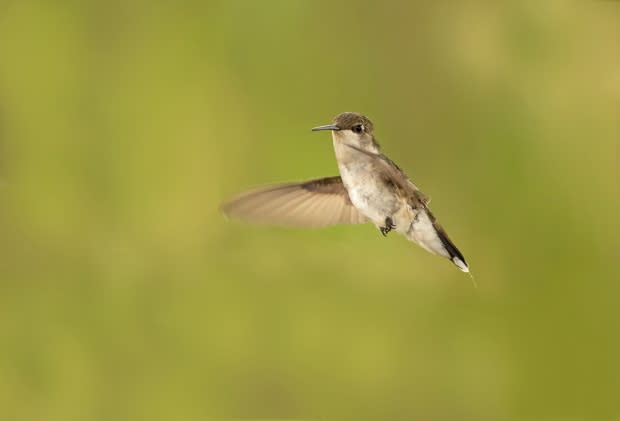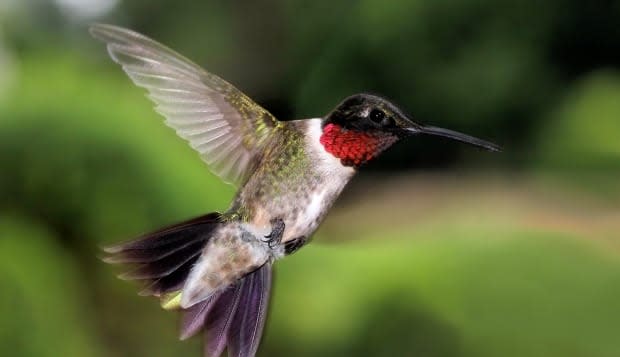Winged wonders: 9 fun facts about hummingbirds

Summer is here and so are the cute little hummingbirds. Here are some fun facts about the quirky ruby-throated creatures for you as you sip your morning coffee.
1. They can live up to 10 years
Cindy Cartwright, founder of and lead researcher for Hummingbirds Canada, comes to P.E.I. every summer to band hummingbirds to see how long they're living and when they're returning to each site.
"Not every hummingbird comes back because they get old and they die or they have a problem along the way, but they usually return to the same site year after year and so we have some hummingbirds that were banded four years ago on Prince Edward Island and they're still returning to the same feeders," she said.
Banding elsewhere in Canada, however, shows that they can live up to 10 years.
"We've had males and females that we've banded as adults, so they were one-year-old or more, and we've recaptured them nine years in a row."
2. They can travel long distances

During the fall and winter, the birds, which weigh less than a penny, can migrate as far south as Costa Rica, said Brendan Kelly, an avid birdwatcher and photographer who works with Island Nature Trust.
"It's pretty impressive given that a hummingbird is smaller than your pinky finger," he said.
In the past, it was thought that hummingbirds would hitch a ride south on the backs of geese, but research shows that is not true, Kelly said.
He said they can fly directly from P.E.I. to Newfoundland without stopping. Hear that, airlines?
3. You can see them at Victoria Park

If you don't have your own feeder, you can head down to the pollinator garden at Victoria Park in Charlottetown and watch them do their thing.
It was set up in 2015 to attract butterflies and hummingbirds, but Beth Hoar, forest and environmental officer for the city of Charlottetown, said the plant species have shifted to attract other pollinators as well.
"Hummingbirds like plants that have sort of tubular flowers and so they are drinking the nectar out of the flowers and in that process they get pollen on their beaks and then they go to another flower and take a drink of nectar and deposit the pollen there," Hoar said.
"So they're pollinating our flowers, which is absolutely necessary for the flowers to reproduce."
The pollinator garden is located on the Brighton Road side of the park, near the playground. Hoar said they plan to put up signs in the area so people can find it more easily.
4. They're not really ruby-throated

Cartwright said people are surprised when she turns a male hummingbird away from the sun and their throat feathers are actually black.
"The feathers are concave shaped. And so depending how much curve each feather has, it reflects at different wavelengths. So the ruby throats is obviously that bright ruby red."
Female hummingbirds don't have the coloured throat features — they are white or grey from their throats down to their tails.
5. They steal spider webs
Imagine if you're a spider and you meticulously build the perfect web and along comes a hummingbird and steals it.
Too bad so sad.
The nest is actually kind of elastic and it will expand with the hummingbirds as they grow in size. — Brendan Kelly
Hummingbirds use them for their tiny nests, which are so small they can be covered by a quarter.
The nests are made from lichens and fibres, but spider webs are ideal for holding them together for a couple of reasons, Kelly said.
"Spider webs are extremely strong and durable.... The nest is actually kind of elastic and it will expand with the hummingbirds as they grow in size."
6. They are used for love potions in some cultures

Hummingbirds used to be hunted and their glittering skins sent to Europe to decorate hats, cloaks and other clothing, Cartwright said, and while this is illegal today, they are still killed and sold in some places for love potions.
"It's a very sad thing," she said. "In parts of Mexico and Central America, there are some people that believe that having a dried hummingbird can help you to find love in life. There's quite a trade going on down there and there's actually an issue with smugglers trying to bring these dried dehydrated hummingbirds into the U.S. to sell to people there as well."
7. They're the only birds that can truly hover or fly backward

That hawk you see appearing to hover is not really hovering, Cartwright said, it's actually heading into the wind, moving its wings very slowly to hold itself there.
That's cheating.
Hummingbirds, on the other hand, move their wings in a figure-eight pattern.
"They don't go up and down like other birds do, so they're pushing air in both directions and that allows them a lot of flexibility in how they move around," Cartwright said. "They're the only species that can actually stay still."
8. They can't walk

If your legs were that short you might not be able to walk either.
"They can't even really shuffle their legs. They are essentially the equivalent of the legs of a helicopter when it lands," Kelly said.
"They are so short they are basically useless other than for landing."
Well, not exactly, those little legs can still reach most the hummingbird's body when it wants to scratch or clean itself, Kelly said.
9. There is still lots to learn

Despite the above, we also don't know much about hummingbirds in Eastern Canada, especially compared with larger birds like waterfowl and raptors, Kelly said.
He said that's why work by Hummingbirds Canada and the Island Nature Trust is so important.
"The goal is to kind of learn more about the birds and hopefully determine how their populations are doing and maybe find ways that we can conserve and protect them."
More P.E.I. news

